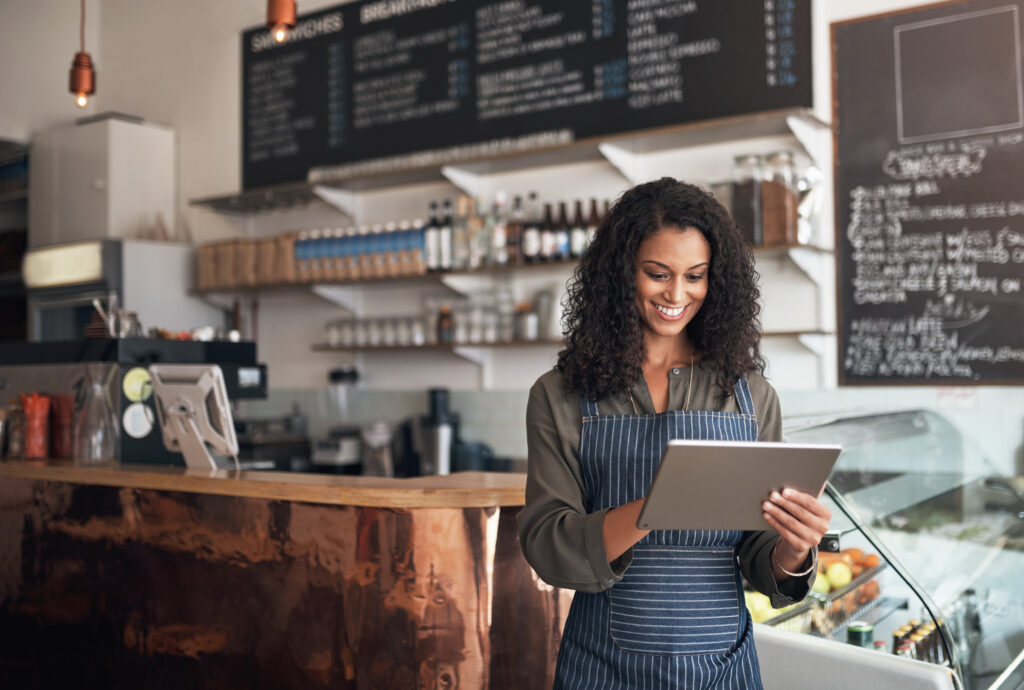20 Ways Technology Has Changed Restaurant Business Best Practices
Running a restaurant has never been more competitive. The restaurant industry in the U.S. is a $997 billion industry. So, how can restaurant owners stand out? Technology is a critical differentiator. Whether it’s to optimize your operations or give a better customer experience, below are 20 ways technology can transform your restaurant business best practices.
Food and labor are two of the biggest costs for restaurants. On top of that, you could be wasting money If you’re still managing your inventory and employees manually. These technologies can help you optimize your supply chain and operations more efficiently.
Inventory and Operations Management
1. Inventory management software
If your restaurant runs out of ingredients or overstocks them, you either disappoint your customers or waste excess food. Using inventory management software instead of paper records, you can track your inventory levels, forecast demand, and identify areas where you can save money.
For example, you can use real-time tracking to monitor your inventory levels anytime, preventing overstocking or understocking items. This way, you make more informed decisions on what and how much ingredients to buy.
Want to prevent stockouts? You can set up automated alerts whenever stock levels fall below a certain threshold. What you want is to ensure your popular menu items are always available.
On the flip side, you also should focus on waste reduction. You can minimize waste by closely monitoring inventory turnover and expiration dates of food items. You can then adjust your purchasing and production accordingly.
2. Scheduling software
Assigning shifts and tracking hours can be stressful for restaurant managers. All the pen-and-paper and back-and-forth scheduling is just time-consuming. Scheduling software takes the headache out of employee schedules by helping you plan and manage your staff shifts, hours, and payroll.
The most obvious benefit of scheduling software is the reduced administrative burden. You can save time and effort on manual scheduling processes, freeing up your time for more strategic tasks.
Your staff will also be less stressed choosing and swapping shifts that work for them as this software allows for employee preferences and availability. You can create schedules that accommodate their individual needs, increasing employee satisfaction and lowering turnover.
On a more strategic level, demand-based scheduling enables you to analyze historical data and trends to create schedules that align with customer demand. For instance, you can prevent overstaffing during slower periods and ensure adequate staffing during peak times.
3. Hiring platforms
Recruitment is another area that can benefit from the use of technology. Online hiring platforms streamline recruitment, making it easy to post job openings, screen applicants, and conduct interviews.
You’ll enjoy time and cost savings as online applications, automated screening, and virtual interviews reduce the time-to-hire and associated costs.
It’s not just efficiency. Hiring platforms offer expanded candidate reach. You can target a wider pool of candidates, including those from diverse backgrounds and locations.
Plus, you get better candidate matching with hiring platforms that employ algorithms to match candidates with your job requirements. You’ll be able to quickly find employees with the skills and experience you’re looking for.
4. High-speed Internet and Fiber Internet
Imagine being unable to use your software or access your POS system because your Internet connectivity is slow. If you want to avoid frustration and wasted time, you need fast Internet connectivity. For example, Cox Business Internet plans have speeds up to 940 MBps with 99.9% network reliability.
Reliable and high-speed Internet supports cloud-based operations. Many restaurant management systems and applications operate in the cloud. You want smooth and always-on access to these systems.
Seamless online orders and payments also depend on high-speed Internet. Whether you accept orders on your website or app, you need to be able to receive these online orders to minimize your customers’ wait times.
Restaurant customers also expect guest WiFi services. And it’s not just for them to stay connected online. It also allows for better customer engagement by using digital menus, promotions, and loyalty programs.
Enhancing the Customer Experience
You’re in the service industry, so it’s a given that you need to focus on delivering a great customer experience. You need a well-trained staff to delight your customers. But you can also use technology to provide convenient, personalized, and efficient service.
5. Curbside service
These days, curbside service has become standard. While it’s not a technology per se, you need to integrate existing technology to make it work. For example, your online ordering platform, point of sale system, and restaurant app should include curbside pickup as an option.
Not everyone wants to dine in or drive through. Customers with limited time or who want takeout food would want the convenience of ordering food online or by phone and having their orders delivered directly to their vehicle. Others may prefer contactless transactions. Curbside pickup does away with cash handling and card swiping since orders have already been paid for in advance.
6. Self-ordering kiosks
Did you know that queuing and ordering at restaurants induce consumer anxiety? One option is to use self-ordering kiosks, which let customers order and pay using interactive touchscreens.
The ordering process is streamlined, which leads to reduced wait times. There’s also more personalization as customers can customize their orders. Placing orders directly through the kiosks also ensures order accuracy and minimizes miscommunication between customers and staff.
7. Reservation platforms
Making restaurant reservations over the phone generally still works. However, allowing customers to book tables online through a reservation platform just offers more convenience and flexibility. For instance, they can view available tables in real time, select the date and time they want, and even choose where they want to sit.
Some platforms feature virtual waitlist management, which notifies customers when their table is ready. Another common function is capacity management, which can help you avoid overbooking tables and manage your peak times.
8. Digital Signage
Updating and changing menus can be a hassle for restaurant managers. You can replace traditional static menus and posters with digital signage. They let you display dynamic interactive content on screens. For instance, you can change menu items, prices, and promotions with real-time updates so your customers always see accurate information.
There’s also greater visual appeal with digital signage, with animated content that can catch customers’ attention. You can also use it for upselling opportunities like showcasing high-margin items and limited-time offers.
9. Private dining management software
Restaurants are popular venues for private events. Instead of back-and-forth phone calls with customers, you can use private dining management software to help you manage these events more efficiently. You can track reservations, send out invitations, and manage event logistics.
There’s more efficient coordination between your customers and restaurant staff since they’re using the same platform. And customers benefit from simplified booking. For instance, they can view available event spaces, layouts, and seating arrangements without visiting your restaurant. There’s also greater customization. Customers can tailor their options by selecting their menu, decor, and AV equipment requirements.
10. Managed WiFi
Why deal with monitoring your wireless network or installing access points when you can outsource this to a third-party provider? Cox, for instance, offers a scalable, fully managed WiFi solution that provides enterprise-level services and handles everything from
Your restaurant benefits from reduced IT costs, freeing your staff to focus on other tasks. You also get enhanced security as managed WiFi providers use various security measures to protect your customers’ personal information and your business data.
Offering your guests free, fast, and secure WiFi can attract more visitors and improve customer loyalty. They’ll stay longer, order more, and are more likely to return.
Streamlining Operations and Efficiency
There’s a lot of wastage in restaurants from excess food, kitchen scraps, or wrong orders. You can use these technologies to reduce waste and minimize errors.
11. Waste Management Systems
You can’t totally avoid food waste. However, you can identify areas where you can reduce it and improve your environmental impact. And that’s where waste management systems come in.
They have features like real-time monitoring of data to help you understand peak waste periods so you can adjust your production accordingly. They also provide insights into the types and quantities of wasted food. You can make better calls on your menu, portion sizes, and inventory with this kind of data-driven decision-making.
Cost reduction is another benefit. You can cut costs from overproduction, excess inventory, and disposal fees. There’s also more efficient sorting as they incorporate intelligent sorting mechanisms that categorize waste for recycling, composting, or disposal.
12. Point-of-sale Technology
Point-of-sale (POS) technology is not exactly new. However, legacy restaurant POS systems were much more limited. Today’s modern POS systems are cloud-based and can generate more data.
For instance, they produce better analytics and reporting on sales trends, peak hours, and popular menu items. You can also integrate them with your inventory management system. With inventory tracking, you can automatically update inventory levels, preventing over- or under-ordering ingredients.
13. Digital Kitchen Boards
Traditional paper orders are prone to errors, causing delays in the kitchen. You can replace them with digital kitchen boards that display and update orders, menus, and tasks on screens. Since these are digital systems, you can get real-time order updates, so your kitchen staff knows what to prepare and when.
Order prioritization for time-sensitive items or VIP guests shows your staff what to cook first. And if guests make any special requests or changes to their orders, you can easily accommodate customization and modifications.
Utilizing Data Analytics and Automation
If you want to make better decisions, you need better data. And if you want to optimize your operations and create personalized customer experiences, you need to use automation.
14. Cloud Services
Almost all software nowadays is hosted on the cloud. Cloud services let you store and access data from your various software applications. With centralized data management and remote access, it’s easier to access and share information and reports. You can also avoid losing your data through automated data backups.
And as your business grows, scalability is not going to be a problem. You can scale faster without having to invest in hardware like servers and storage.
15. Data-driven Marketing
You can use your customer data to create more effective and relevant marketing campaigns. For example, you can develop more personalized offers by analyzing your customers’ purchase history.
With segment targeting, you can categorize your customers based on demographics and purchase history, for example. And with tailored content and offers, you can expect improved engagement from your customers.
16. Customer Sentiment Analysis
You can get customer feedback through paper surveys. However, you may not know what your customers say about your restaurant online. Customer sentiment analysis uses technology to understand customer opinions.
How does it work? Sentiment analysis tools process customer reviews and social media mentions. This feedback monitoring can give insights into how customers feel about your products, services, and brand.
And since you can catch negative sentiments in real-time, you can offer a quick response to issues. Addressing them promptly will prevent potential reputational damage.
17. Demand Forecasting
Based on historical data and seasonal trends, you can predict how much food you need to prepare and plan customer demand. Data-driven demand forecasts minimize overstocking and understocking of ingredients. You can save costs and cut waste with more accurate inventory planning.
Demand forecasting also works for efficient staff scheduling. For instance, you can schedule staff based on anticipated customer traffic. During slower days, you can reduce labor costs while still maintaining excellent service.
18. Personalized Customer Experiences
As your restaurant grows, it gets harder to provide personalized service. This is where personalization technology can help. One area is menu recommendations. You can suggest menu items based on their order history, for instance.
Another way of personalizing the customer experience is through your loyalty programs. You can reward customers with offers that resonate with them. Offering personalized customer experiences makes it easier to earn repeat business and improve customer retention.
19. Artificial Intelligence (AI)
Everyone’s talking about AI these days. You can use AI to automate tasks, such as scheduling and inventory management. AI algorithms can analyze sales data to predict demand and optimize inventory levels.
Dynamic pricing is an automated way of maximizing revenue without much effort. AI can adjust menu prices based on availability, demand, and time of day.
You can also use AI to improve customer service. For instance, AI-powered chatbots and virtual assistants can handle customer inquiries and reservations 24/7. They can even suggest menu items, reducing the load on your staff.
20. Robotics
Will robots take over restaurant staff? Not really. But they can make them more productive. Robots can automate tasks that are currently done by your staff, such as prepping, cleaning, and delivering food.
They are also less likely to make errors than humans, especially when performing repetitive tasks. You can improve the quality and consistency of your food and service with fewer errors.
These are ways technology can bring you a competitive edge. Embracing these technologies improves efficiency, reduces costs, and opens up new avenues for growth and creativity.
FAQ’s
Here is a set of 5 compelling FAQs based on the article:
Question: How can restaurants use technology to better manage inventory and food costs?
Response: Restaurants can use inventory management software to track ingredient levels in real-time, set up alerts when stock is low, monitor food waste, and adjust purchasing based on usage data. This prevents overstocking or running out of key ingredients.
Question: What types of software help restaurants optimize staff scheduling?
Response: Scheduling software analyzes historical data for customer traffic patterns. It then helps create demand-based schedules that prevent overstaffing during slow periods and ensure adequate staffing during peak times. This saves on labor costs.
Question: How does technology allow restaurants to provide better customer experiences?
Response: Self-ordering kiosks reduce wait times and allow custom orders. Reservation platforms enable convenient online bookings and table management. Digital signage displays dynamic, up-to-date menus, prices, and promotions for accuracy. Loyalty programs use purchase data to provide personalized deals.
Question: How can restaurants use data to boost marketing and sales efforts?
Response: Customer data analytics provide insights to help segment customers and create targeted campaigns with relevant offers. Data-driven demand forecasts also assist in inventory planning and efficient staff scheduling to optimize operations.
Question: What emerging technologies are helping transform restaurants?
Response: Artificial intelligence handles tasks like inventory optimization and dynamic pricing. Chatbots manage reservations and customer inquiries 24/7. Robotics automates certain functions in the kitchen like food prep and plating to reduce errors and improve quality/consistency.
- Celebrating the NWA LPGA Championship: A Community and Sporting Triumph - October 23, 2024
- Why Local and State Governments Must Scale Broadband Infrastructure Now - October 16, 2024
- Modernize Operations in Quick-Service Restaurants (QSRs) with A Full Tech Stack - October 10, 2024


